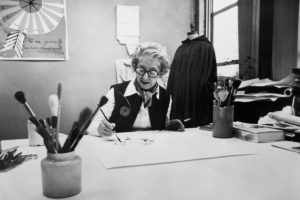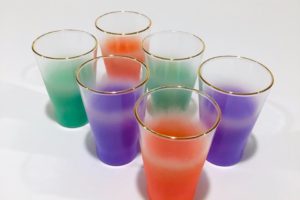Blendo Glassware Demystified: Part 1
Who made Blendo?
Have you been searching the internet endlessly for information about the highly collectable mid-century modern glassware known as Blendo only to find the same few sentences repeated, often riddled with conflicting information? Me, too. I set out to set the record straight.
Of course, if the history of Blendo was straight forward, this article would be unnecessary. To keep things simple, I created two posts. This one dives into production, and Blendo Glassware Demystified: Part 2, The Many Colors of Blendo examines colors and styles.
Let’s start with a general description so we are all on the same page. Blendo is a specific line of crystal glassware with a sprayed-on decoration that gives an ombre effect. The color graduates from solid color at the foot to clear glass at the top. “Bright gold trim” was a signature of the line. Glasses had gold on the rim, larger items had a thin gold band around the neck or verge.

Who made Blendo? According to Dean Six, author of the book West Virginia Glass Between the World Wars, quoted by Atomic Ranch, Blendo “was made by and only by West Virginia Glass Specialty of Weston, W.V.” While most blogs and online product listings agree with Six, I found a Blendo Chip and Dip listed on eBay with an original Colonial Glass label. I reached out to the Museum of American Glass in West Virginia for clarification, and Tom Felt was happy to help.
According to Felt, the overwhelming majority of Blendo was made by West Virginia Glass Specialty. However, “there is a definite relationship between Blendo and Colonial [Glass Company], though a somewhat confusing one.”
In fact, a 1968 catalogue page from Colonial shows four different pitcher and glass drinking sets in the Blendo pattern with the description “Decorated Golden Mist” and list of six available colors. I asked Felt if they would be considered knockoffs, and his reply was “possibly, but probably not.” How could there be such confusion? These two glass companies were in the same town, Weston, WV, and were owned by a group of families whom often had an interest in both.
In the publication West Virginia Blendo Glass: Collecting Blendo from the West Virginia Glass Specialty Company, Earlo Pertz, a former president of Specialty, was quoted saying “Louie Wohinc had an interest in more than one company and sometimes he would open an order at one of them and have it made and shipped from a different factory where there was temporarily more capacity. This sometimes would produce questions from surprised customers.”

That clears it all up, right? Nope. We still have a few loose ends. In 1971, Anchor Hocking showed one style of cocktail drinking set in the Blendo pattern. It was a snifter-style rounded cocktail pitcher with a foot with six rounded glasses in two colors, light blue and light green. Where did these come from? While it is technically possible that Anchor Hocking produced these, it is far more likely that they were purchased from Specialty or Colonial in an effort to include a very popular style in their offerings. It is known that AH purchased finished Blendo pieces from either Specialty or Colonial and added further decoration, as in their “Happy Hour” line.
But wait, there’s more. In 1976 the L.E. Smith Glass Company offered the “Spray Mist Collection” in their catalogue (see image). It included three drinking sets, a chip n’ dip, and a salad set in the Blendo style, available in four colors – Banana, Strawberry, Blueberry, and Lime/Mint. What is the connection? I am speculating, but they could have purchased the pieces from Colonial or Specialty to add the popular line to their catalogue, just as with AH.


Clearly, the many American glass companies actively did business with one another. One more supply chain of note is that many of the Blendo glasses were made from blanks purchased from the Federal Glass Company in Columbus, Ohio. The prevailing opinion is that the spray-on decoration provides the defining characteristic of Blendo, and therefore Specialty is credited for these pieces. To come full circle, Specialty sold blanks to many glass cutters to cut and sell as their own.
What about production timeline? The first reference to “Fired-in Ceramic Color Decorations,” which is attributed to Blendo, appeared in an advertisement in July 1956 (see image). Full production was up and running by 1959. The 1982 Specialty catalogue cover shows only Blendo, illustrating what a prominent part of the business it had become. Due to competition with imported goods, however, the company closed its doors in 1986.
What is the takeaway? The vast majority of Blendo is credited to West Virginia Glass Specialty, and production was in its hay day in the 1960s and 1970s.
Check-out Blendo Glassware Demystified: Part 2, The Many Colors of Blendo
Thank you to Tom Felt from the Museum of American Glass in West Virginia (MAGWV). You can purchase their many publications on American glass through their eBay store, including the monograph about Blendo referenced in this post.
















